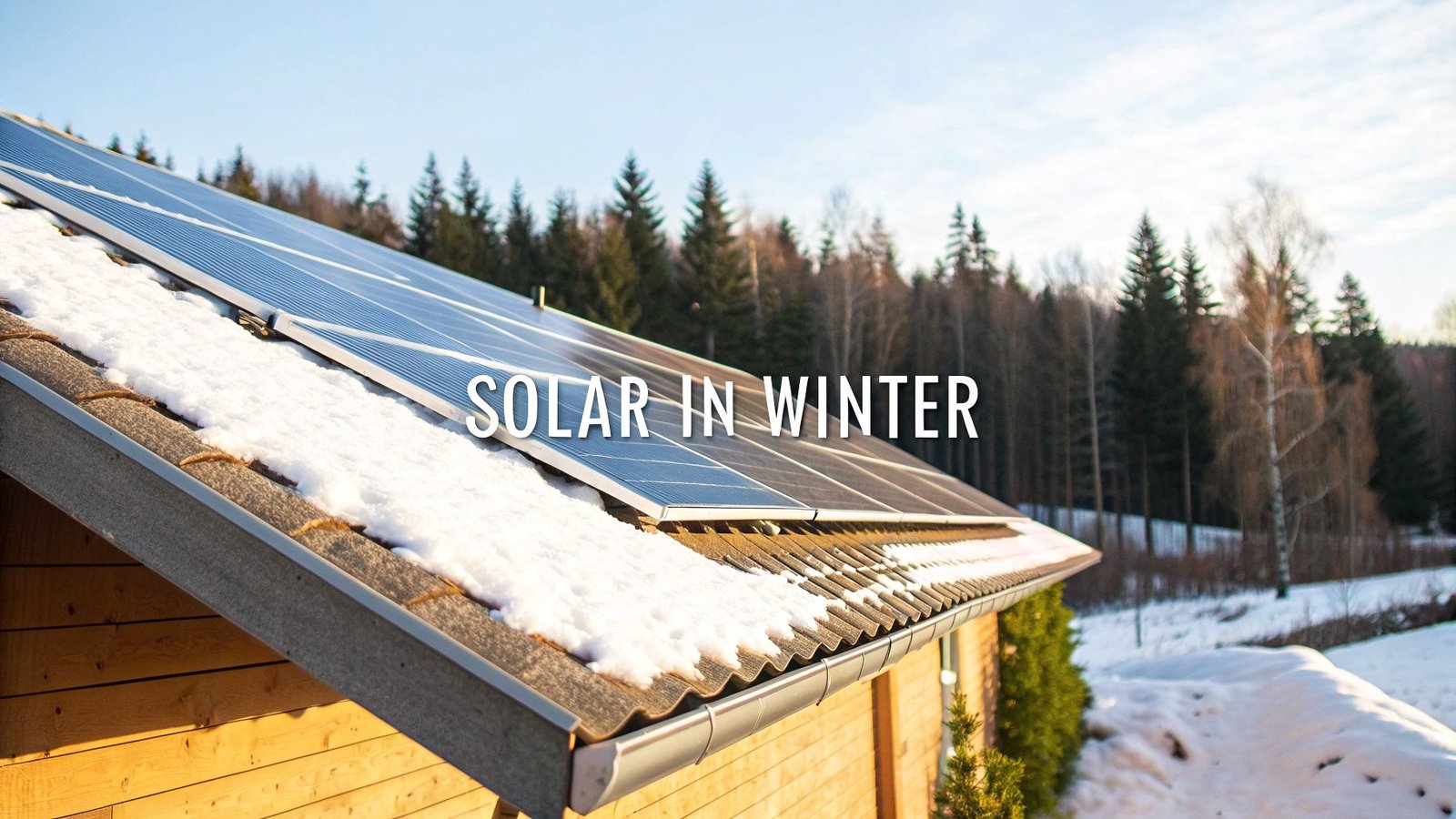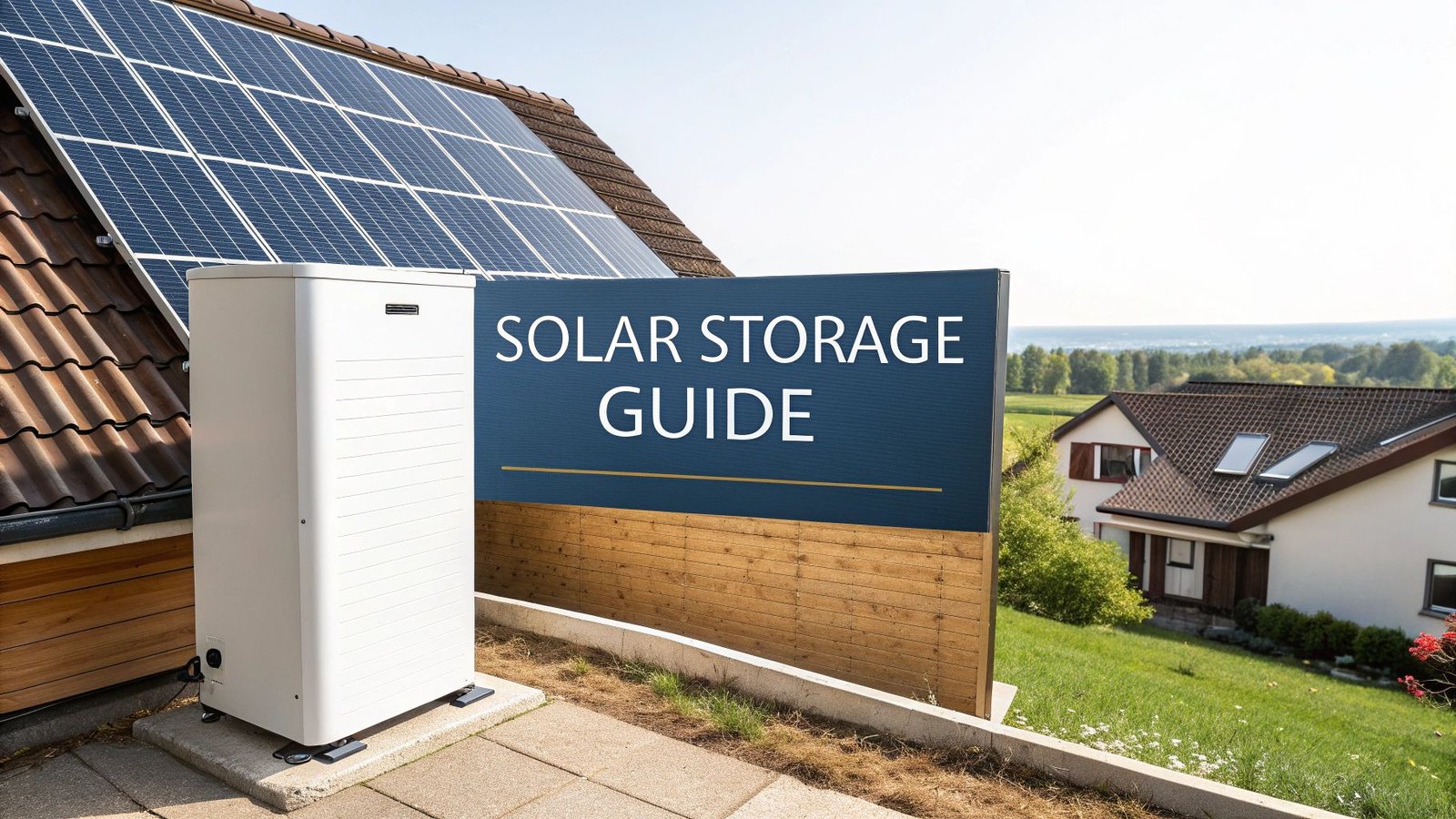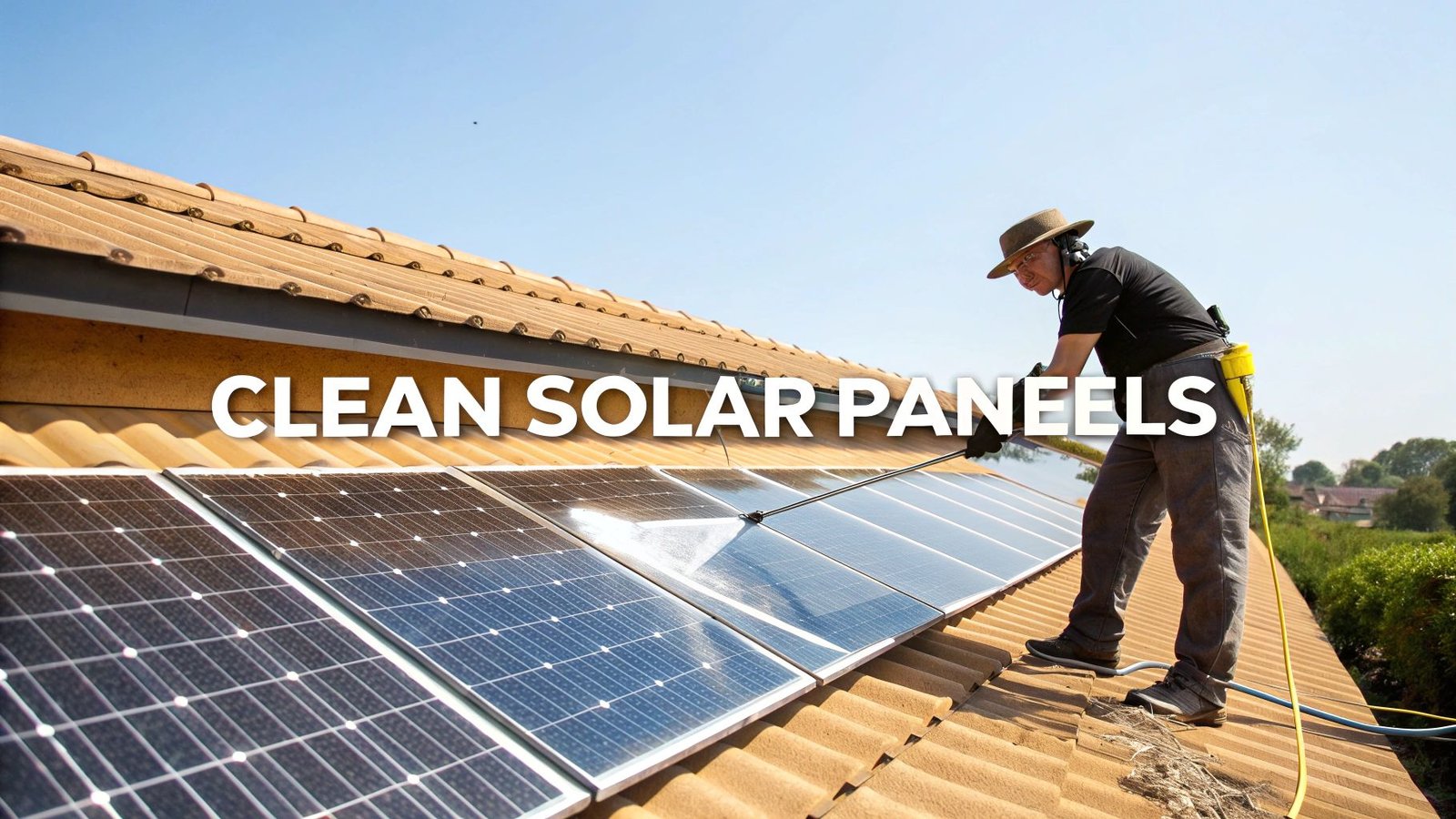It’s a fair question, and one I hear all the time: "Do my solar panels just give up during the winter?" It seems logical, right? The days are shorter, the sun feels a million miles away, and everything is cold. But the answer is a resounding yes, solar panels absolutely work in the winter.
In fact, there's a surprising twist. Cold, crisp winter days can actually help your panels perform more efficiently than they do during a sweltering summer heatwave. The real culprit for lower winter production isn't the temperature; it's simply a matter of getting enough daylight.
The Surprising Truth About Winter Solar Power
Let's bust one of the biggest myths about solar power right now. Solar panels run on light, not heat. It's a common mix-up, but your panels are designed to capture photons from sunlight, and they couldn't care less about the temperature on your thermostat.
Think of it like your laptop or smartphone. Have you ever noticed it getting sluggish and hot when you’re running a demanding program? Electronic components just don't like excessive heat—it creates resistance and slows things down. Solar panels are no different. The intense heat of a July afternoon actually creates more electrical resistance inside the solar cells, making it harder for electricity to flow.
Winter weather does the opposite. The cold acts as a natural coolant, reducing that internal resistance and letting electrons move freely. This means that for every hour of direct sunlight they get, your panels can convert that light into electricity more effectively on a chilly January day than on a blazing August one.
What Really Affects Winter Performance
While the cold is a welcome friend to your solar array, a few other environmental factors have a much bigger say in your total energy output. Getting a handle on these will give you a realistic picture of what to expect when the seasons change.
- Sunlight Hours: This is the big one. Winter days are simply shorter, giving your panels fewer hours to do their job.
- Sun Angle: The sun also hangs much lower in the sky. Its rays strike your panels at a more oblique angle, which is less potent than the direct, overhead sun of the summer.
- Weather: Overcast days and heavy cloud cover will definitely reduce your output, though panels still produce some power in these conditions. And, of course, a thick blanket of snow can block the sun entirely until it melts or is cleared off.
Let's take a quick look at how these elements balance out.
Winter Solar Performance Factors at a Glance
This chart breaks down the main environmental factors and how they specifically impact your solar panel output during the winter months.
graph TD
subgraph Positive Impact
A[Cooler Temperatures] --> B{Higher Efficiency}
end
subgraph Negative Impact
C[Shorter Daylight Hours] --> D{Less Generation Time}
E[Lower Sun Angle] --> F{Less Intense Light}
G[Increased Cloud Cover] --> H{Reduced Output}
I[Snow Accumulation] --> J{Blocked Sunlight}
end
B --> K((Overall Winter Production))
D --> K
F --> K
H --> K
J --> K
style A fill:#D4EDDA,stroke:#C3E6CB
style B fill:#D4EDDA,stroke:#C3E6CB
style C fill:#F8D7DA,stroke:#F5C6CB
style D fill:#F8D7DA,stroke:#F5C6CB
style E fill:#F8D7DA,stroke:#F5C6CB
style F fill:#F8D7DA,stroke:#F5C6CB
style G fill:#F8D7DA,stroke:#F5C6CB
style H fill:#F8D7DA,stroke:#F5C6CB
style I fill:#F8D7DA,stroke:#F5C6CB
style J fill:#F8D7DA,stroke:#F5C6CB
As you can see, it's a bit of a trade-off. The improved efficiency from the cold helps offset the reduced sunlight, but shorter days will always be the dominant factor in overall winter production.
The biggest misconception is that heat equals power. The reality is that your panels’ efficiency is all about light exposure. Cold weather is actually a performance booster, letting the electronics inside run cooler and smoother.
This principle holds true even in some of the coldest places on earth. Unless temperatures drop to an incredibly rare -40°F (-40°C), your panels will operate just fine. You can find more great info on how cold weather impacts solar panels on ratedpower.com.
Now that we have the basics down, let's dig a little deeper into exactly how much power you can expect to generate when winter sets in.
How Cold Weather Unlocks Peak Panel Efficiency
It might sound strange, but solar panels don't just work in the winter—they often work better. The secret isn't about heat; it's about the physics of converting sunlight into electricity. It all boils down to a concept called electrical resistance.
Think of your solar panel as a superhighway for energy. The electrons are the cars, and their job is to get from the solar cell into your home's wiring as fast as they can. On a scorching summer day, the intense heat gets the atoms inside the panel all jiggled up. This creates a massive traffic jam, increasing electrical resistance and slowing down the flow of electrons.
Cold weather has the opposite effect. The chilly air acts like a natural coolant, calming down those agitated atoms. This clears up the highway, massively reducing resistance and letting electrons flow freely and smoothly. The upshot? For every ray of sunlight a panel soaks up, it can convert it into usable electricity more efficiently on a cold day than on a hot one.
The Temperature and Voltage Connection
The link between temperature and a solar panel's performance is direct and easy to measure. As the air temperature drops, the panel's voltage—a key indicator of its electrical power—actually goes up. This boost means you get more power out of every hour of sunlight.
Most standard solar panels are tested at a baseline temperature of 77°F (25°C). For every degree the temperature drops below this benchmark, the panel's efficiency typically gets a little bump.
This efficiency gain is a huge reason why solar panels perform so well in winter, even in places known for their bitter cold. A fascinating study from the Northern Alberta Institute of Technology (NAIT) found that energy loss from snow coverage was just 3% over a five-year period. This really drives home that temperature plays a much bigger role than most people think.

As you can see in the graph, there’s a clear inverse relationship. The colder it gets, the higher the voltage climbs, leading to more efficient energy production. This is exactly why a crisp, sunny winter day can be a real powerhouse for solar generation.
Why This Matters for Your System
Grasping this principle helps you set realistic expectations for your system's performance year-round. The specific type of panel you install also plays a part in how well it handles temperature swings. Taking some time to learn cómo elegir paneles solares can give you a much better feel for the materials and technologies that will work best for your local climate.
At the end of a day, while shorter winter days mean less total sunlight to capture, the improved efficiency during those hours helps make up for it. This neat scientific advantage ensures your investment keeps delivering value, proving that when it comes to solar power, a little bit of cold can be a very good thing.
Working with Shorter Days and a Lower Sun
While cold weather actually gives solar panels a slight per-hour efficiency boost, the real hurdle for winter production is far more basic: there’s just less sunlight to go around. Two key factors are at play here, and understanding them is crucial for setting realistic expectations for your system’s output during the colder months.
First, and most obviously, winter days are shorter. This gives your panels a smaller window of time each day to capture sunlight and convert it into electricity.
The second factor is the sun's position in the sky. In summer, the sun arcs high overhead, hitting your panels with direct, powerful rays. But in winter, it traces a much lower, shallower path. This means sunlight strikes your panels at a less-than-ideal angle, spreading the same amount of energy over a wider surface and reducing its intensity.
Visualizing the Sun's Path
Here's a good way to think about it: imagine watering a plant with a garden hose. If you point the nozzle directly down, you get a powerful, concentrated stream. But if you hold the hose at a low angle, the water fans out into a much gentler, less focused spray. The sun's energy is a lot like that—the low winter sun delivers a less concentrated "spray" of light.
This image really helps drive the point home, showing how these seasonal shifts impact your system's potential.

As you can see, even with perfect, clear conditions, the simple physics of daylight hours and sun angle set the ceiling for winter energy production.
Putting It All Together
So, what does this actually mean for your energy bills? It means that even though your solar panels are technically working more efficiently for every hour they're in the sun, the total daily energy production will be lower than what you see in the summer. This seasonal dip is completely normal and something every solar owner experiences.
The key is to manage expectations. Your panels are still doing their job, but they simply have less fuel—sunlight—to work with. The combined effect of shorter days and a lower sun is the number one reason for reduced winter output.
Winter months certainly present a few challenges. In places like the UK, for example, shorter daylight hours are compounded by the sun’s low trajectory, meaning less direct sunlight reaches the panels. Still, even with these limitations, they continue to generate electricity, just at a lower rate. You can discover more insights about solar energy in winter to see how this plays out.
Getting a handle on this predictable, seasonal shift is the first step toward making sure your system is optimized for the best possible performance all year long.
How Snow and Clouds Affect Your Energy Production
When winter rolls in, the two biggest concerns I hear from homeowners are snow and clouds. It's a common assumption that a gray sky or a blanket of snow means your solar panels have clocked out for the day. But that's not quite how it works. The reality is far more interesting and often, more productive than you’d think.
So, do solar panels work when they're covered in snow? The short answer is, it depends. A thick, heavy layer will definitely stop production in its tracks by blocking sunlight. But a light, fluffy dusting? That often has a surprisingly small impact. Sunlight can actually pierce through a thin layer of snow, and the dark surface of the panels naturally absorbs heat, which helps that light accumulation melt away on its own.
The Surprising Upside of Snow
Here’s something that catches many people off guard: snow isn't always the villain. Once your panels are clear, a fresh blanket of snow across your yard can actually give your energy production a serious boost.
This phenomenon is known as the albedo effect. Think of fresh snow as a massive, natural mirror laid out on the ground. It reflects sunlight back up into the atmosphere, and some of that reflected light hits your panels. On a crisp, clear day following a snowfall, this can lead to a noticeable jump in your system's output.
Of course, a heavy, persistent snowstorm that buries your panels is another matter entirely. In most setups, the tilt of the panels is enough to help snow slide off naturally as the sun comes out. If you're dealing with major accumulation, however, it's worth knowing the right way to handle it. You can find some great tips in our guide on solar panels and snow removal.
What About Those Gray, Overcast Days?
It's one of the biggest myths in solar: that panels need bright, direct sunshine to make electricity. The truth is, they are still perfectly capable of generating power from the diffused, ambient light that makes its way through cloud cover.
Your panels are far from useless on a cloudy day. A typical system might still produce 10% to 25% of its maximum output, which is still valuable energy offsetting your home's consumption.
Ever gotten a sunburn on a cloudy day at the beach? It's the same principle. The sun's UV rays are still getting through, they're just scattered instead of direct. Your panels are engineered to capture this scattered light and keep the power flowing.
In the rare event that extreme winter weather like a heavy ice storm causes physical harm to your array, it's best to call in professionals. You may need the help of specialized storm damage repair contractors to assess and fix any issues safely.
A Closer Look at Winter Weather Impacts
To really nail down what to expect, it helps to see how different winter weather scenarios stack up against each other. This chart illustrates the typical impact on a residential solar panel system.
graph TD
A[Clear Sunny Day] --> B(90-100% Output)
C[Light Overcast] --> D(30-50% Output)
E[Heavy Cloud Cover] --> F(10-25% Output)
G[Light Snow Dusting] --> H(70-90% Output)
I[Heavy Snow Cover] --> J(0% Output)
style A fill:#e0f7fa
style C fill:#cfd8dc
style E fill:#90a4ae
style G fill:#e3f2fd
style I fill:#fafafa
As you can see, your solar production doesn't just fall off a cliff when winter arrives. It fluctuates based on the specific conditions of the day, but it almost never drops to zero unless the panels are completely buried.
Actionable Tips to Maximize Winter Solar Output

Knowing how winter impacts your solar panels is one thing, but actually doing something to improve their performance is where the real power lies. Thankfully, there are several practical steps you can take to squeeze every last drop of energy from your investment during the colder, darker months.
The biggest bang for your buck comes from optimizing your panel’s angle. The sun hangs much lower in the sky during winter, so giving your panels a steeper tilt can dramatically increase how much direct sunlight they catch. This simple adjustment goes a long way in making up for the less intense winter sun.
A steeper angle also has a fantastic side benefit: it helps snow slide right off. The dark surface of the panels naturally warms up, melting the bottom layer of snow, and gravity takes care of the rest. This trick minimizes the time your panels are out of commission after a big snowfall.
Smart Cleaning and Snow Removal
It goes without saying that keeping your panels clear of snow and debris is crucial for winter production. A heavy, wet blanket of snow will grind your energy generation to a halt. But a light, fluffy dusting? That will often melt away on its own as soon as the sun peeks out.
When you do get a significant pile-up, clearing it safely is your top priority. For ground-mounted systems or panels you can easily reach, a long-handled snow rake with a soft head works wonders. But I can't stress this enough: never climb on an icy roof to clear your panels. It’s just not worth the risk.
For more detailed safety tips, check out our guide on https://radiantenergysolar.com/how-to-clean-solar-panels/ to learn how to do it without causing damage or getting hurt.
A five-year study by the Northern Alberta Institute of Technology (NAIT) found that energy loss from snow coverage was just 3%. This research highlights that while snow is a factor, proper panel angle and natural shedding handle the issue most of the time.
Upgrading Your System for Winter Conditions
Beyond basic upkeep, some technologies are built to thrive in winter. Looking into these options can give your system a serious advantage when sunlight is at a premium.
- Bifacial Panels: These are pretty amazing. They capture sunlight from both the front and back. In snowy landscapes, this is a huge win because they absorb the sunlight that reflects off the bright white ground (this is called the albedo effect), boosting your total output.
- Battery Storage: Pairing your solar array with a home battery completely changes the game in winter. It lets you bank the extra energy you generate on a clear afternoon and use it that night or during a gloomy, low-production day. You essentially create your own personal energy reserve, making you less dependent on the grid when you need it most.
- Energy Efficiency at Home: Your solar production is only half the story; how much energy you use is the other. Reducing your home's energy demand means your solar system doesn't have to work as hard. Simple things like using specialized window treatments can make a big difference. You can Learn about solar shades for passive energy management to see how you can cut down on your home's heating needs.
By putting these tips into action, you can give your system the support it needs to perform its best all winter long. You’ll get the maximum value from your investment and prove that solar panels are more than capable of delivering great results, even in the cold.
Your Winter Solar Questions, Answered
Even after getting the facts, it's totally normal to have a few more questions rattling around. Let's tackle some of the most common things homeowners wonder about, so you can feel confident in how your system will perform when the temperature drops.
Will a Heavy Snowstorm Break My Solar Panels?
This is probably the number one question we get, and for good reason. The short answer? It's extremely unlikely. Solar panels are tough—seriously tough. They go through a battery of stress tests before ever leaving the factory, designed to make sure they can handle the heavy, wet weight of several feet of snow without any structural issues.
The real problem with snow isn't the weight; it's that a thick blanket of it stops sunlight from reaching the cells. But a professional installer accounts for this. They design the whole system—from the racking to the roof attachments—to easily manage the weight of your local area's average snowfall.
Is Solar Even Worth It If I Live Somewhere Cloudy and Snowy?
Yes, one hundred percent. People are often surprised to learn that Germany, a country famous for its gray skies, is a world leader in solar energy. The secret is that your system's value is based on the total sunlight it gets over an entire year, not just on the sunniest days.
Even on a completely overcast day, your panels are still working, typically producing 10% to 25% of what they would in direct sun. Plus, programs like net metering are built for this very reason. You can bank extra energy credits during those long summer days and draw on them during the shorter, darker days of winter. This makes solar a fantastic investment, even in snowy climates.
The real measure of a solar system’s success isn't perfect weather. It’s a smart design that considers the full picture of a year’s worth of sunlight, delivering value in every season.
Should I Get on the Roof and Clear the Snow Off My Panels?
Let’s talk safety first: please don't. Climbing onto an icy, snow-covered roof is incredibly dangerous, and we strongly advise against it.
The good news is that you rarely have to. Panels are installed at an angle for a reason. Once the sun peeks out, the dark surface of the panel heats up just enough for the snow to start melting and sliding right off on its own.
If you have a ground-mounted system that you can reach safely from the ground, you could use a special tool like a long-poled snow rake with a soft foam head. But for any panels on your roof, the best—and safest—plan is to just let nature take its course. If you get a massive, stubborn snowfall that won't budge, the only truly safe option is to call a professional.
Winter weather doesn't have to stand in the way of your energy goals. The team at Energía radiante is all about designing solar systems built to perform year-round, specifically for our local climate. Start your journey to a sustainable future today.




